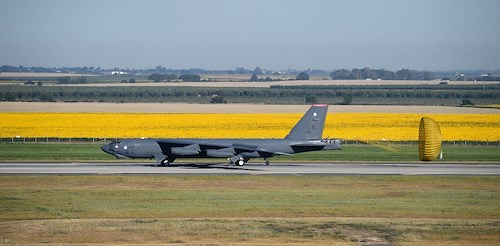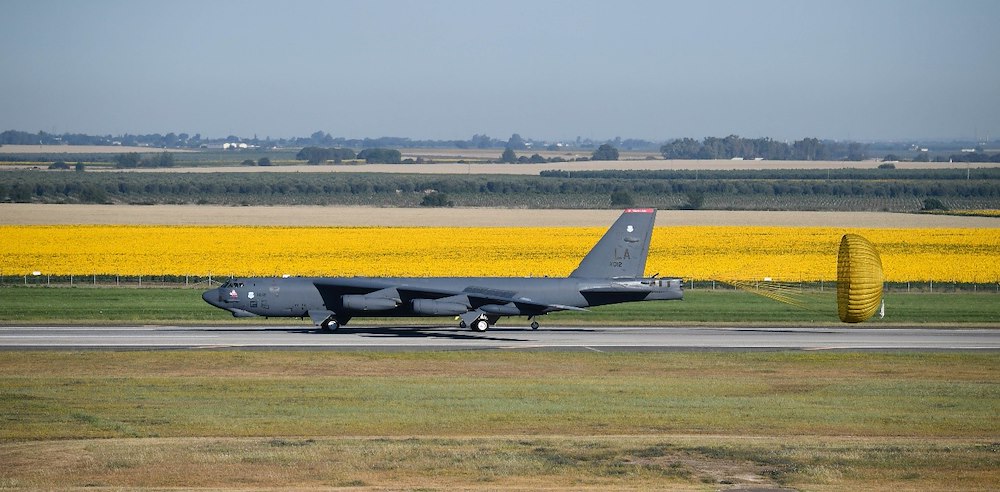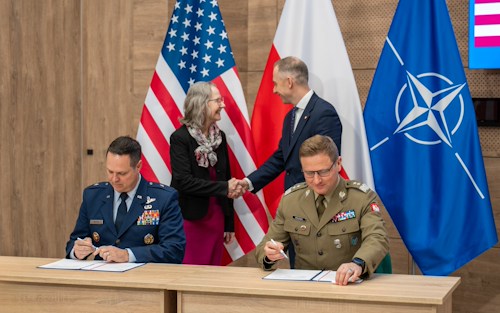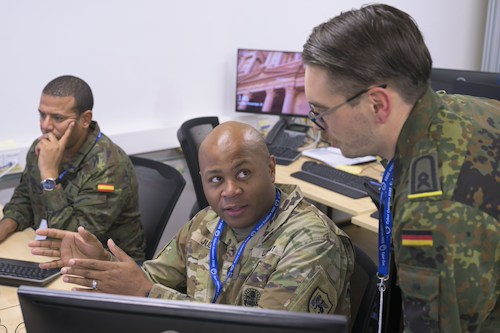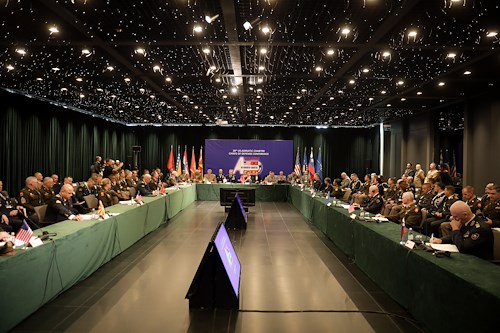Gallery contains 2 images
×
Photo 1 of 2
B-52H Stratofortress Bomber
B-52H Stratofortress bomber landing at Morón AB, Spain
Photo by: 2Lt Aileen Lauer
Photo 2 of 2
B-52H Stratofortress Bomber
B-52H Stratofortress bomber launching from Barksdale AFB, LA
Photo by: SrA Jacob B. Wrightsman
United States Air Force B-52H Stratofortress long-range bombers charged to the pinnacle of precise and simultaneous execution of global operations and pushed the line of deterrence forward during Operation APEX CHARGER II.
Building on Operation APEX CHARGER in September 2020, the U.S. Strategic Command, in close coordination with four of the U.S. Department of Defense’s Geographic Combatant Commands, put Operation APEX CHARGER II into motion on May 17th. This Bomber Task Force event literally took flight by launching six B-52H nuclear capable bombers from bases in the U.S.to fly training missions all over the world, traversing parts of Africa, Asia, Europe, Oceania, as well as North America.
This event demonstrated the ability of U.S. forces to plan, command, control, and conduct synchronized air operations on an unmatched global scale. One set of bombers launched from Andersen Air Force Base in Guam and flew northwest to fly along the Pacific coasts of Japan and Russia, then returned to the Continental U.S. through Alaska and Canada. Another set of bombers launched from Barksdale Air Force Base in Louisiana and flew across the Atlantic Ocean to individual routes into the Baltic, Mediterranean, and Norwegian Seas, as well as overland the Baltic States, Eastern Europe, and North Africa, then landed at Morón Air Base in Spain. The six bombers took off from their respective bases at staggered times to follow routes of flight that placed them simultaneously at strategic points around the globe.
As a demonstration of the flexibility of the Bomber Task Force employment model, these bombers flew their Operation APEX CHARGER II missions as either a part of a return from a deployment to the Indo-Pacific region or as part of forward deploying to European region. Prior to adoption of the Dynamic Force Employment strategy, the long-range bombers maintained a continuous and very predictable presence in the Indo-Pacific region. This operation further demonstrated the continuous state of readiness, reliability, resilience, and freedom of action of U.S., allied and partner nation forces, as this global activity took place during an operational lull in the exercise schedule of Chinese and Russian military forces.
The bombers of APEX CHARGER II also demonstrated the agility of capabilities supporting global deterrence. Deterrence is an active posture, through both diplomatic and military channels, to prevent armed conflict between nations. The standard icon of military deterrence is the U.S.’s nuclear triad, composed of ground-based intercontinental ballistic missiles, long-range bombers, and sea-based submarine-launched ballistic missiles. These nuclear triad forces regularly train and exercise skills for a mission that all hope will never occur. While eight nations currently acknowledge having nuclear weapons, only three of those “nuclear club” members have the air, land, and sea capabilities to maintain a nuclear triad: China, Russia, and the United States of America.
Regarding the current state of deterrence Admiral Charles Richard, commander of U.S. Strategic Command, recently testified to the U.S. House of Representatives Armed Services Committee: “For the first time in our nation's history we are about to face two nuclear capable strategic peer adversaries at the same time, both of whom must be deterred differently.” The elements of deterrence change due to circumstances, but the overall posture of deterrence must be maintained as a hedge against another world war.
While nuclear triads are a primary deterrent to war between global competitors, strong alliances between free nations provide another line of deterrence and belt of protection against designs to shackle free people. These long-range bomber flights reinforced cooperation and unity of purpose among allies and partner nations, and showed credible military capability to preserve peace. A primary means of cooperation with allied and partner nations was through the aircraft conducting integration training with air and ground elements of their armed forces, for APEX CHARGER II these countries included: Denmark, Norway, Poland, Spain, Sweden, and the United Kingdom.
While not as aerobatic as a flight demonstration team like the U.S. Navy’s Blue Angels or the Royal Air Force’s Red Arrows, the long-range bombers of Operation APEX CHARGER II demonstrated precision flight choreography on a truly global scale. “The speed, flexibility, and readiness of our strategic bombers play a critical role in our ability to deter potential adversaries and signal our unwavering support to our allies and partners,” said Admiral Charles Richard. “Missions like this provide invaluable training opportunities with our allies and partners to improve our interoperability and demonstrate that our forces are capable of operating anywhere, anytime, to meet any challenge decisively.” In a New Era of Strategic Competition, the US, its allies, and partners stand ready and vigilant to preserve global peace and push deterrence forward.

